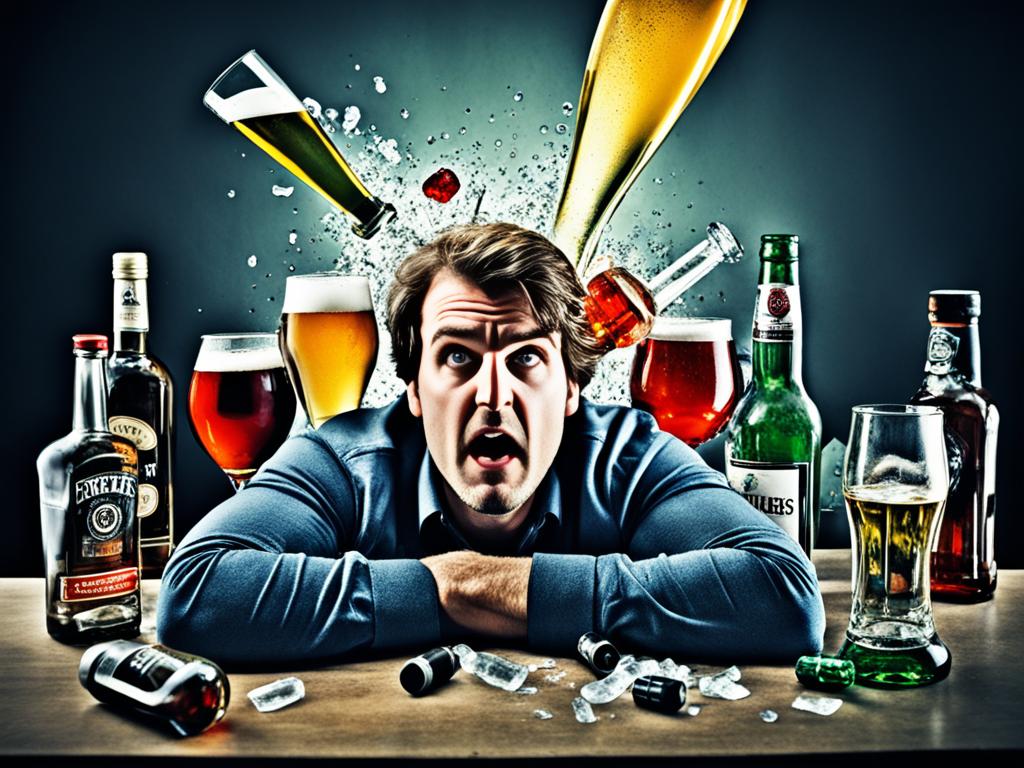Welcome to a journey of discovery as we dive into the world of alcohol and unravel the facts that often get lost in the buzz. Whether you’re a casual drinker or a connoisseur, understanding the science, history, and common myths surrounding alcohol can enhance your appreciation and help you make informed decisions about your favorite beverages.
Throughout this article, we will delve into the fascinating process of alcohol fermentation, explore the rich historical perspectives of alcohol through the ages, debunk common myths, and provide insights into responsible drinking practices. By the end, you’ll have a well-rounded understanding of alcohol and the tools to enjoy it responsibly.
Key Takeaways:
- Gain a comprehensive understanding of the science, history, and common myths surrounding alcohol.
- Explore the intricate process of alcohol fermentation and its role in producing various beverages.
- Discover the historical perspectives of alcohol and its cultural significance throughout different civilizations.
- Bust common myths surrounding alcohol to separate fact from fiction.
- Learn practical tips for responsible drinking and making informed choices.
The Process of Alcohol Fermentation
Understanding how alcohol is produced is key to comprehending its effects. In this section, we’ll explore the intricate process of alcohol fermentation, the biological transformation that gives rise to a wide range of alcoholic beverages. From the conversion of sugars to the role of yeast, we’ll take a closer look at this fascinating process.
The Science Behind Alcohol Fermentation
Alcohol fermentation is a natural metabolic process that occurs when yeast consumes sugar and converts it into alcohol and carbon dioxide. This process is anaerobic, meaning it takes place in the absence of oxygen. Yeast, a type of fungus, is the primary catalyst for alcohol fermentation. Different strains of yeast produce varying types and flavors of alcohol.
During fermentation, the yeast feeds on the sugars found in fruits, grains, or other fermentable substances, such as grapes for wine or barley for beer. These sugars can come from natural sources or be added during the brewing process. As the yeast consumes the sugar, it releases enzymes that break down the carbohydrates into simpler compounds, such as glucose and fructose.
Next, the yeast undergoes a series of chemical reactions, converting the glucose and fructose molecules into ethanol (alcohol) and carbon dioxide. This process is known as glycolysis. The carbon dioxide produced during fermentation is responsible for the bubbles and effervescence in sparkling wines and beers.
The Factors Influencing Alcohol Fermentation
Several factors influence the alcohol fermentation process and determine the final product:
- Yeast Strain: Different strains of yeast have varying tolerance levels for alcohol and produce different flavors and aromas.
- Fermentation Temperature: The temperature at which fermentation occurs affects the rate and outcome of the process. Cooler temperatures slow down fermentation, while warmer temperatures can speed it up.
- Fermentable Sugars: The type and amount of sugars available for fermentation impact the flavor, sweetness, and alcohol content of the final product.
- Additional Additives: Brewers and winemakers may introduce additional ingredients, such as hops or oak chips, to add complexity and enhance the flavor of the beverage.
The Duration of Alcohol Fermentation
Alcohol fermentation can take anywhere from a few days to several weeks, depending on various factors. During this time, the yeast continues to convert sugar into alcohol until either all the sugar is consumed or the alcohol concentration reaches a level that inhibits further fermentation. To achieve specific alcohol levels and flavors, brewers and winemakers carefully monitor and control the fermentation process.
| Alcoholic Beverage | Primary Ingredient | Typical Alcohol Content |
|---|---|---|
| Beer | Malted/wheat barley | 3-9% ABV |
| Wine | Grapes | 12-15% ABV |
| Whiskey | Grains (corn, barley, rye, wheat) | 40-60% ABV |
| Vodka | Grains or potatoes | 35-50% ABV |
Alcohol fermentation is a complex process that has been refined over centuries, resulting in a vast array of alcoholic beverages enjoyed today. Whether sipping on a glass of wine, savoring a cold beer, or indulging in a fine whiskey, understanding the science behind alcohol fermentation adds a new level of appreciation for the drinks we love.
Alcohol Through the Ages: Historical Perspectives
Alcohol has a rich history that spans centuries, leaving an indelible mark on human culture. Throughout time, alcohol has played significant roles in social gatherings, religious ceremonies, and even medicinal practices. Understanding the historical perspectives surrounding alcohol allows us to gain insights into its origins, cultural significance, and its lasting impact on different civilizations.
From ancient times to the present day, alcohol has been intertwined with human experiences and has shaped social interactions. The production and consumption of alcoholic beverages have varied across different cultures and regions, with each society leaving its unique imprint on the beverage.
Alcohol through the ages has been a source of pleasure, symbolizing celebration and joy in many societies. It has been a companion in times of merriment and a form of solace during hardships. Additionally, alcohol has been an integral part of religious rituals, serving as offerings to deities or representing spiritual connections.
Historical perspectives shed light on the diverse uses of alcohol throughout time. In ancient civilizations such as Mesopotamia, Egypt, and the Indus Valley, beer was a staple beverage that played a crucial role in daily life. It provided sustenance, nutritional value, and served as a safer alternative to contaminated water.
The production and consumption of wine in civilizations such as Greece and Rome were not only associated with socializing but also indicated status and sophistication. The Greeks even had a god, Dionysus, dedicated to wine and revelry. Wine became a symbol of culture, refined tastes, and intellectual pursuits.
Throughout history, alcohol has often been intertwined with exploration and trade. The Age of Exploration and the voyages of famous explorers like Christopher Columbus and Vasco da Gama introduced alcoholic beverages to new lands, shaping cultural exchanges and transforming beverage preferences.
As we travel further in time, we discover the historical perspectives of alcohol in prohibition eras, where various regions and countries implemented restrictions on the production, sale, and consumption of alcohol. These periods, marked by social movements and legal regulations, have influenced the way society views and regulates alcohol today.
In summary, alcohol through the ages has reflected the values, traditions, and customs of different civilizations. It has been a companion in celebration, a conduit for religious connections, and a catalyst for cultural exchange. Appreciating the historical perspectives allows us to grasp the ever-evolving relationship between humans and alcohol and recognize the impact it has had on our societies.
Medieval Brewing Techniques
The medieval period witnessed significant advancements in brewing techniques, with monasteries playing a crucial role in preserving and refining the art of beer production. Monks meticulously cultivated yeast strains, experimented with ingredients, and documented their brewing processes. Their dedication to the craft laid the foundation for modern brewing practices.
| Name | Description |
|---|---|
| Ancient Mesopotamia | Beer was commonly consumed and considered a staple food. |
| Ancient Egypt | Wine played a significant role in religious ceremonies and had a strong association with the afterlife. |
| Ancient Greece | Wine consumption was an important part of social gatherings and intellectual pursuits. |
| Roman Empire | Wine was a symbol of sophistication and an indicator of societal status. |
| The Middle Ages | Monasteries played a crucial role in preserving brewing knowledge and techniques. |
| Prohibition Era | Alcohol was heavily regulated and restricted in many regions to combat perceived social issues. |
Debunking Myths About Alcohol
When it comes to alcohol, myths and misconceptions abound. These false beliefs can often lead to misunderstandings and misinformed decisions. In this section, we will separate fact from fiction and debunk common myths about alcohol.
One common myth is the belief that mixing different types of alcohol leads to worse hangovers. However, this is not backed by scientific evidence. While excessive alcohol consumption can result in a hangover, the specific type of alcohol you consume does not affect the severity of the symptoms.
Another widespread myth is the famous saying, “beer before liquor, never been sicker.” This is simply a myth. The order in which you consume alcoholic beverages has no impact on their effects. It’s the total amount of alcohol consumed that determines the level of intoxication, not the order in which you drink.
Myth: Drinking coffee or taking a cold shower sobers you up faster.
An often-repeated myth is that drinking coffee or taking a cold shower can sober you up quickly. This is not true. While caffeine may make you feel more alert, it does not reduce your blood alcohol concentration. The only way to sober up is to allow your body enough time to metabolize the alcohol.
It’s also important to dispel the notion that alcohol will keep you warm in cold weather. This is a dangerous misconception. While alcohol may create a warm feeling, it actually lowers your core body temperature, putting you at a greater risk for hypothermia in cold environments.
Now that we’ve debunked some common myths about alcohol, it’s crucial to base our understanding on scientific facts and make informed choices when it comes to consuming alcoholic beverages. Remember, responsible drinking begins with accurate knowledge.
Myths About Alcohol Debunked:
- Drinking different types of alcohol does not lead to worse hangovers.
- The order in which you drink alcoholic beverages does not affect their effects.
- Coffee and cold showers do not sober you up quicker.
- Alcohol does not keep you warm in cold weather; it lowers your body temperature.
Takeaway
By debunking these common myths about alcohol, we can separate fact from fiction and make more informed decisions. Remember, responsible drinking is about enjoying alcohol in moderation and prioritizing your well-being.
Responsible Drinking: Taking Control
When it comes to enjoying alcohol, responsible drinking is key. By embracing moderation and making informed choices, you can ensure a positive and enjoyable experience. In this section, we’ll share some valuable tips and guidelines for responsible drinking that prioritize your well-being.
Understanding Alcohol Units
One way to maintain responsible drinking habits is to understand alcohol units. The amount of alcohol in a beverage is measured in units, and knowing the standard unit sizes can help you keep track of your intake. It’s important to be aware of the recommended unit limits for men and women, and to pace your drinking accordingly. By monitoring your alcohol units, you can make informed decisions about how much to consume.
Staying Hydrated
Staying hydrated is crucial for responsible drinking. Alcohol is a diuretic, which means it can contribute to dehydration. To counter this effect, make sure to drink plenty of water alongside your alcoholic beverages. Hydrating yourself throughout the night can help minimize the negative effects of alcohol and prevent excessive intoxication. Remember, staying hydrated leads to a more enjoyable and safer experience.
Knowing When to Say When
Responsible drinking also involves knowing when to say when. It’s important to recognize your limit and understand the signs of intoxication. Consuming alcohol in a controlled manner allows you to stay in control of your actions and make responsible decisions. If you start feeling the effects of alcohol, it’s always best to stop drinking and switch to non-alcoholic alternatives. Your well-being should always be the top priority.
“Responsible drinking means enjoying alcohol in moderation while prioritizing your personal health and safety.”
By implementing these responsible drinking practices, you can ensure that you have a positive and safe experience when consuming alcohol. Remember, responsible drinking is about taking control and making informed choices that align with your well-being. When it comes to enjoying alcohol, moderation is the key.
Conclusion
As we conclude our journey through alcohol facts, it’s essential to emphasize the significance of knowledge in making responsible decisions. Armed with a deeper understanding of the science behind alcohol fermentation, the historical context of its cultural importance, and the debunking of common myths, you are now equipped to navigate the world of beverages with confidence.
Remember, responsible drinking is about moderation and informed choices. By practicing responsible drinking habits, such as monitoring your alcohol units and staying hydrated, you can optimize your enjoyment while prioritizing your well-being.
Ultimately, the key takeaway is that knowledge is power. The more you understand about alcohol, the better equipped you are to make informed decisions that ensure an enjoyable and safe experience. So, embrace your newfound knowledge, and let it guide you as you embark on your future encounters with alcoholic beverages.







